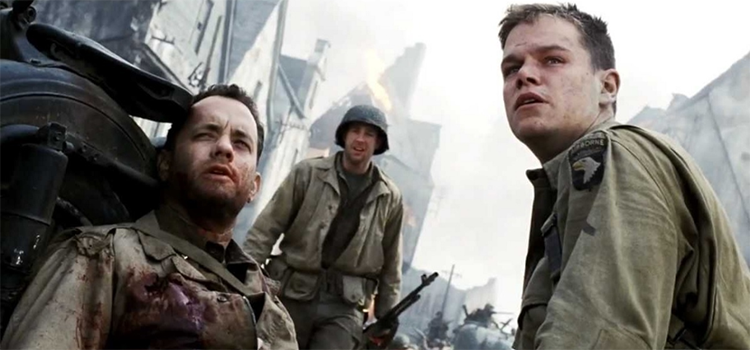There’s no doubt about it. Steven Spielberg’s 1998 war epic, Saving Private Ryan, was a masterpiece in every aspect of filmmaking. It won five of the eleven Academy Awards for which it was nominated. The immense scale of the invasion of Normandy was expertly recreated for film in a way that hasn’t been replicated since — and likely never will be.
Despite the massive war that characterizes the film, the movie’s primary conflict wasn’t between warring nations, but rather between Tom Hanks’ character, Captain Miller, and his duty to return Pfc. Ryan (as played by Matt Damon), who refuses to leave behind the brothers with whom he’d fought so far.
The film, being the masterpiece that it is, wraps the story up nicely, leaving few loose ends, but there’s that ever-burning question in Hollywood — how do you make that special lightning strike twice? How can you create another story surrounding the incomparable D-Day and find just as much success?
The truth is, simply, that you can’t. The story has already been perfectly told by one of the finest filmmakers in Hollywood at just the right moment. But that doesn’t mean that the story has necessarily ended…
As stated by Jack Knight of War History Online, there is serious interest in following-up Saving Private Ryan by continuing the story of the Rangers at D-Day and the mission that occurred at Pointe du Hoc. What made the beach landing scene so spectacular wasn’t the battle itself, but rather how the battle was seen — through Capt. Miller’s eyes.
The audience felt the immense gravity of war in a truly human way. In one moment, we’re listening to a guy joke on the landing craft; one second later, his blood is splattered on Miller’s face. This is the essence of what made Saving Private Ryan so great. World War II was just the backdrop to a more personal story, but the sheer, raw horrors of war were still very much present.
The audience saw the enemy in the distance, but the focus was entirely on the Capt. Miller. Any spiritual successor (or direct sequels) should keep that in mind.
What made this scene so great wasn’t the $12 million put into it — it was Tom Hank’s reaction to everything happening around him.
(DreamWorks Pictures)
Such a sequel, a movie that follows someone’s personal life after a major conflict, has been dreamt up before. One film, known as “the greatest war film never made,” that was to explore this theme was to be called The Way Back.
The 1955 film To Hell and Back was an amazing anomaly. It was the World War II experience of Audie Murphy, based on the autobiography of the same name that was written by Audie Murphy and David McClure, starring Audie Murphy himself. But this wasn’t the only film the war hero wanted to make. Everyone wanted to see his heroic stand on the back of the Sherman, but he never got the finances for the script that told the story of what happened after he was bestowed the Medal of Honor.
He struggled daily with post-traumatic stress. His family life was, to put it lightly, troubled. He turned to drugs and alcohol to cope with the pain. He even famously locked himself in a dirty motel room to kick his morphine addiction. He was lost in a world that wanted “him,” but not the real him. But he knew countless children looked up to him, so he put one foot in front of the other with a forced smile on his face.
This movie, were it ever made, would’ve been a powerful piece. Audie Murphy, arguably the greatest soldier to ever don a uniform, would’ve told everyone that not everything is fine when the war’s over. There’s a pain there that nobody can see, but many of us feel.
It’s a grim reality, but it’s comforting in it’s own way.
(Metro-Goldwyn-Mayer)
War films are a dime a dozen in Hollywood and rarely will they have any impact on the public because they’re just action scenes after action scenes until the credits roll. If Hollywood really wanted a powerful message to send to the world, they could make a grounded story following the life of one of the Rangers after D-Day. Use Saving Private Ryan’s personal approach and make it about one soldier. They could keep the action scenes, but make them a background to the story of just surviving. Then, as Act II rolls around, shift the story to show how a returning soldier survives this world he left behind to fight in D-Day.
Hollywood could have their cake and eat it to while also sending a powerful message to the countless returning veterans of the Post-9/11 wars, telling them that they’re not alone.
It’s not like there are too many war films out there specifically made for Post 9/11 vets. The bar is set kinda low…
(Summit Entertainment)
More From We Are The Mighty
5 Reasons Why Troops Stick Together After the Military
4 Reasons Why Showering On Deployment is Disgusting
7 of the Greatest Songs Every Veteran Knows
6 Things You’d Take Back Before Leaving the Military
6 Dumb Things Veterans Lie About on the Internet
Follow We Are The Mighty on Twitter
READ NEXT: 5 OF THE BEST THINGS TO HAPPEN IN THE FIELD
READ NEXT: 5 REASONS WHY YOU’LL NEVER FORGET YOUR FIRST DRILL SERGEANT
READ NEXT: 5 OF THE MOST ACCURATE MILITARY REPRESENTATIONS ON SCREEN












